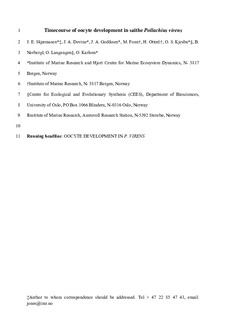Timecourse of oocyte development in saithe Pollachius virens
Skjæraasen, Jon Egil; Devine, Jennifer Ann; Godiksen, Jane Aanestad; Fonn, Merete; Otterå, Håkon Magne; Kjesbu, Olav Sigurd; Norberg, Birgitta; Langangen, Øystein; Karlsen, Ørjan
Journal article, Peer reviewed
Accepted version

View/
Date
2017Metadata
Show full item recordCollections
- Articles [3016]
- Publikasjoner fra CRIStin [3074]
Abstract
Wild caught North Sea saithe Pollachius virens were monitored for growth, sex steroid profiles and oocyte development pre-spawning and measured for egg size and group fecundity during the spawning season in the laboratory. Vitellogenesis commenced in late October–early November, at a leading cohort size (CL) of c. 250 µm, after which oocytes grew rapidly in size until spawning started in February. Notably, a distinct cortical alveoli stage was virtually absent with yolk granules observed in developing oocytes at the very beginning of vitellogenesis. Little atresia was observed pre-spawning, but atretic re-absorption of remnant oocytes containing yolk granules was found in all females immediately post-spawning. As expected, concentrations of sex steroids, oestradiol-17β (females), testosterone (both sexes) and 11-ketotestosterone (both sexes), increased pre-spawning before dropping post-spawning. The present experiment provides the first validation of sex steroid levels in P. virens. Post-ovulatory follicles were visible in histological sections from female gonads 9–11 months post-spawning, but then disappeared. Spawning commenced around a CL of c. 750 µm (700–800 µm). Hydrated oocytes (eggs) measured between 1·04 and 1·31 mm (mean = 1·18 mm) with decreasing sizes towards the end of spawning. The average estimated realized fecundity was c. 0·84 million eggs (median female total length, LT = 60 cm). Spawning lasted from 13 February to 29 March.